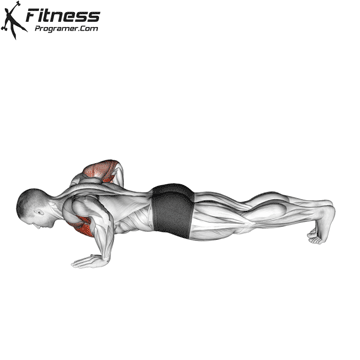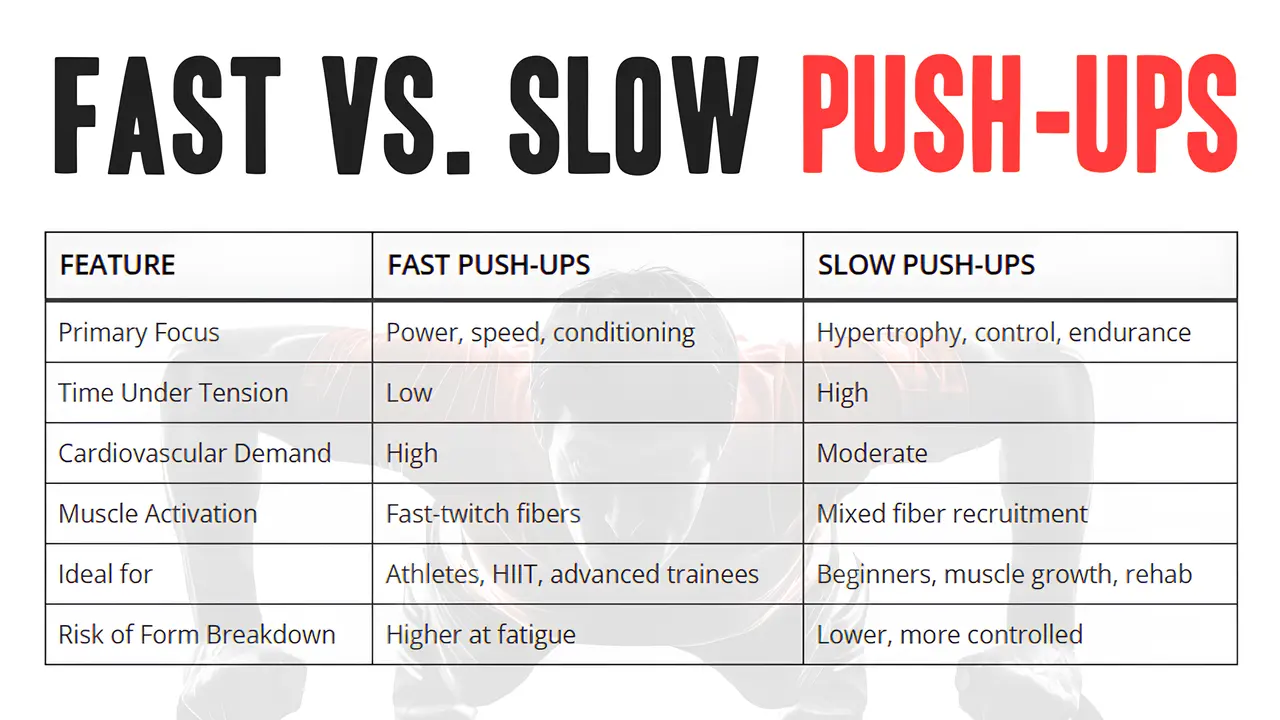Contents
Push-ups are one of the most accessible and effective bodyweight exercises. But did you know that the speed at which you perform push-ups can significantly influence your results? Whether you’re training for strength, size, or endurance, the tempo of your push-ups—fast or slow—can change how your muscles respond.
In this article, we’ll explore the science behind fast vs. slow push-ups, the benefits and drawbacks of each style, and how to choose the right tempo based on your fitness goals and training level.
Understanding Tempo in Push-Ups
Tempo refers to the speed at which you move through each phase of an exercise:
- Eccentric (lowering phase)
- Isometric (pause at the bottom)
- Concentric (pushing phase)
For example:
- A fast push-up might be done in 1 second down, 1 second up (1-0-1 tempo).
- A slow push-up might be 3 seconds down, 2-second pause, and 3 seconds up (3-2-3 tempo).
These tempo variations significantly affect muscle recruitment, energy systems, and training adaptations.
Benefits of Fast Push-Ups
1. Explosive Strength and Power Development
Fast push-ups (e.g., clapping push-ups, push-up hops) target type IIb fast-twitch fibers, essential for speed and high-force output. Benefits include:
- Useful for power athletes, combat sports, and field sport conditioning
- Improved rate of force development (RFD)
- Greater explosiveness in sports (e.g., sprinting, throwing, jumping)
Many sports require explosive upper-body force production—e.g., punching, blocking, diving, tackling. Fast push-ups train the specific velocity and coordination patterns needed in real-world scenarios.
2. Enhanced Neuromuscular Efficiency
Performing push-ups quickly sharpens the nervous system’s communication with muscles:
- Increases motor unit recruitment speed
- Improves firing frequency and synchronization
- Develops reactive strength—important for agility and quick movements
3. Cardiovascular and Metabolic Conditioning
Because of the rapid tempo and greater repetitions, fast push-ups elevate heart rate quickly:
- Effective in HIIT circuits or metabolic resistance training
- Improves cardiorespiratory endurance
- Burns more calories per unit of time, especially when used in intervals
Benefits of Slow Push-Ups
For coaches and athletes aiming to maximize gains, incorporating controlled, slow movements into their resistance training protocol is a highly effective strategy.
1. Greater Time Under Tension (TUT)
Slow push-ups (e.g., 3–6 seconds per rep) significantly increase the time muscles spend under mechanical load, a key driver of hypertrophy. By slowing down both the eccentric (lowering) and concentric (pushing) phases, you create:
- Greater muscle fiber recruitment, especially type I and IIa fibers
- Enhanced metabolic stress (burn) that contributes to muscle growth
- Higher intramuscular tension, which stimulates protein synthesis
Prolonged contraction duration restricts blood flow (occlusion), causing a build-up of lactate and other metabolites. This creates a hormonal response that supports:
- Muscle hypertrophy (e.g., increased growth hormone)
- Enhanced local muscular endurance
- “Pump” sensation that helps with muscle growth signaling
2. Improved Motor Control and Mind-Muscle Connection
Slow tempo enhances proprioception—your body’s awareness in space—making it easier to feel which muscles are working.
- Reinforces correct form and stability, especially in beginners
- Teaches proper alignment and joint control
3. Reduced Joint Strain
Because there’s less momentum, the connective tissues (tendons, ligaments, joint capsules) experience less shock. This makes slow push-ups:
- Safer for those with shoulder or wrist issues
- Appropriate for rehab or prehab programs
- Better for older adults or deconditioned clients
Scientific Insights on Tempo Training
1. Slower Tempos Boost Muscle Activation and Hypertrophy
A 2016 study published in the Journal of Strength and Conditioning Research found that longer eccentric phases—as seen in slow push-ups—resulted in greater muscle activation and hypertrophy compared to faster repetitions. This highlights the effectiveness of controlled movement and extended time under tension in stimulating muscle growth.
2. Faster Tempos Enhance Neuromuscular Efficiency and Power
In contrast, explosive tempos have been shown to significantly improve neuromuscular efficiency and power output, particularly when integrated with bodyweight or plyometric movements. Cormie et al. (2010) demonstrated that high-velocity training increases the recruitment of fast-twitch muscle fibers, which are responsible for explosive, high-force movements.
3. Slow-Speed Resistance Training Improves Strength and Size in Trained Individuals
Pereira et al. (2016), in their study “Resistance training with slow speed of movement is better for hypertrophy and muscle strength gains than fast speed of movement,” found that slow repetition speeds led to greater increases in muscle cross-sectional area and one-repetition maximum strength in well-trained adults. This challenges the assumption that advanced trainees require only high loads or explosive movements for progress.
4. Endurance and Volume: Fast Push-Ups Dominate
While slow push-ups increase TUT, fast push-ups allow for more total repetitions before fatigue. The 2020 study found:
- Participants completed 33% more reps at a fast pace
- However, slow push-ups allowed for 20–24% longer total endurance time
Practical Takeaway
Slow tempos allow for greater mechanical tension, muscle fiber recruitment, and metabolic stress, all of which are known to stimulate muscle hypertrophy. Conversely, fast, explosive tempos serve a distinct role in developing power and athletic performance, showing that both tempo styles have valuable applications depending on training goals.
Fast vs. Slow Push-Ups: Side-by-Side Comparison
| Feature | Fast Push-Ups | Slow Push-Ups |
|---|---|---|
| Primary Focus | Power, speed, conditioning | Hypertrophy, control, endurance |
| Time Under Tension | Low | High |
| Cardiovascular Demand | High | Moderate |
| Muscle Activation | Fast-twitch fibers | Mixed fiber recruitment |
| Ideal for | Athletes, HIIT, advanced trainees | Beginners, muscle growth, rehab |
| Risk of Form Breakdown | Higher at fatigue | Lower, more controlled |
How to Incorporate Both Into Your Program
1. Use Fast Push-Ups for Conditioning or Power Sets
- Plyo Push-Ups (chest tap)
- Clapping Push-Ups
- Drop Push-up
- EMOM or AMRAP drills
- Superset with squats or sprints for full-body effect



2. Use Slow Push-Ups for Muscle Building and Mechanics
- 3–4 seconds down, 1–2 second pause, 2 seconds up
- Perform 3-4 sets to failure for hypertrophy.
- Ideal for chest and triceps-focused training blocks
3. Contrast Tempo Sets
- Superset with 3 sets of 10–12 fast push-ups or plyometric push-ups
- 3 sets of 10–15 slow push-ups (4 sec eccentric + 2 sec concentric)
Switching tempo builds a more complete training stimulus and prevents plateaus.
Safety Tips
- Warm up shoulders and wrists before explosive push-ups
- Maintain neutral spine and scapular control
- Stop if form deteriorates—especially at high speed
- Don’t sacrifice range of motion for rep speed
Conclusion
The choice between fast and slow push-ups doesn’t come down to one being “better”—it’s about selecting the right tempo for your current goal. Whether you’re looking to increase explosive strength, build muscle, improve endurance, or simply maintain joint integrity, both fast and slow push-ups have their place in a balanced fitness program.
Understanding how tempo influences training adaptations helps you train smarter—not just harder.
References
- Pereira PEA, Motoyama YL, Esteves GJ, Quinelato WC, Botter L, Tanaka KH, Azevedo P. Resistance training with slow speed of movement is better for hypertrophy and muscle strength gains than fast speed of movement. Int J Appl Exerc Physiol. 2016;5(2) Google Schola
- Burd, N.A., Andrews, R.J., West, D.W.D. et al. Muscle time under tension during resistance exercise stimulates differential muscle protein sub-fractional synthetic responses in men. J Physiol. 2012. https://pubmed.ncbi.nlm.nih.gov/22106173/
- Muscle activation during various push-up variations and tempos. J Strength Cond Res. 2016;30(7):2068–2073.
- Cormie P, McGuigan MR, Newton RU. Developing maximal neuromuscular power: Part 1–biological basis of power. Sports Med. 2010;40(9):717–740.
- Schoenfeld BJ. The mechanisms of muscle hypertrophy and their application to resistance training. J Strength Cond Res. 2010;24(10):2857–2872.
- Journal of Medical and Biological Engineering: Effect of Push-up Speed on Upper Extremity Training until Fatigue (January 2011)
- American College of Sports Medicine. ACSM’s Guidelines for Exercise Testing and Prescription, 11th ed.



